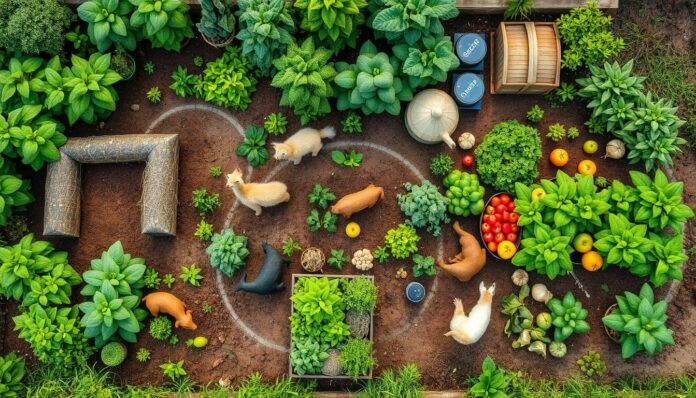Imagine living in a world where everything works together like nature. This is the idea behind permaculture material cycles. It’s a growing trend in the sustainability world. Permaculture aims to manage resources in a way that’s good for the planet.
By using permaculture, we can make our lives more eco-friendly. It helps us live in harmony with nature. This way, we can reduce waste and make our ecosystems more balanced.
Permaculture material cycles focus on managing resources wisely. This method can cut down on waste and improve our environment. It’s been shown to save resources by 20-40% and boost production by 15-25%.
By understanding and using permaculture, we can make our systems more sustainable. This leads to a better future for our planet.
Key Takeaways
- Permaculture material cycles promote sustainable resource management and minimize waste.
- Implementing permaculture design can lead to a reduction in resource expenditure by 20-40%.
- Permaculture material cycles can improve production by 15-25% with proper data tracking.
- Effective water management is crucial in permaculture, utilizing techniques such as swales and rain gardens.
- Soil health is prioritized in permaculture, with practices aimed at increasing beneficial soil biota and carbon sequestration.
- Permaculture material cycles involve the careful management of resources to promote ecological balance.
What are Material Cycles in Permaculture?
Material cycles in permaculture focus on the flow of energy, water, and nutrients. They aim to make a system sustainable and regenerative. This idea is based on ecological design principles, which highlight the need to understand and work with nature.
By using circular economy practices, permaculture systems reduce waste and make the most of what they have. This approach helps create a better environment.
Managing resources like water and nutrients efficiently is key. This can be done through:
- Composting and recycling nutrients
- Implementing efficient water management systems
- Utilizing gravity-assisted nutrient transport
By following circular economy practices and ecological design principles, permaculture systems become more sustainable. They reduce waste and use resources better. This not only helps the environment but also makes things more efficient and productive. It leads to a more sustainable future.
Principles of Permaculture Design
Permaculture design is based on three main principles: earth care, people care, and fair share. These principles help create systems that are regenerative and sustainable. They use regenerative agriculture to improve soil health and increase biodiversity. Organic waste management is also key, as it reduces waste and promotes nutrient cycling.
Some important strategies for permaculture design include:
- Observing and working with natural patterns in the environment
- Using diverse plant species to reduce pest outbreaks and disease
- Implementing organic waste management techniques, such as composting and vermiculture
- Designing systems that promote water efficiency and conservation
By following these principles and strategies, permaculture design can create sustainable systems. This is true for small gardens and large farms alike. Using regenerative agriculture and organic waste management improves soil health, biodiversity, and ecosystem functioning. This leads to a more sustainable future.
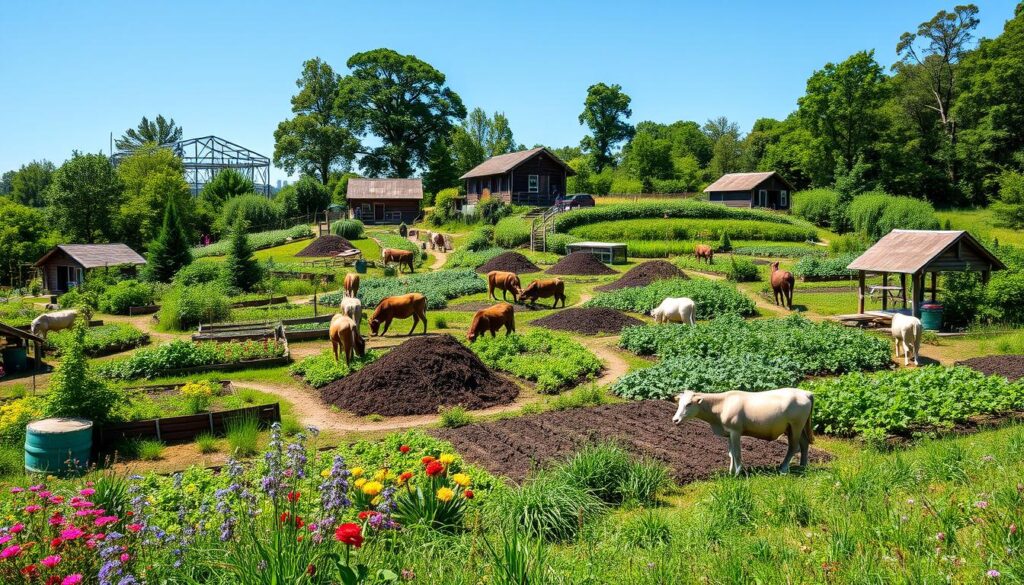
Types of Material Cycles
Permaculture material cycles are key for managing resources sustainably. They fall into three main types: nutrient, water, and energy cycles. Knowing about these cycles helps in building systems that are regenerative and self-sufficient. For more on permaculture, check out the permaculture Wikipedia page.
Nutrient cycling keeps soil fertile without needing outside help. This is done through composting and using worm bins to turn food scraps into useful products. Water cycling, on the other hand, is about managing water well, like catching rainwater for various uses.
Energy cycling is also vital. It’s about using renewable energy and making energy use more efficient. By using these cycles, permaculture systems can lessen their environmental footprint and support sustainable resource use.
Some important ways to start these cycles include:
- Using materials found locally for design and upkeep
- Practicing energy efficiency
- Encouraging biodiversity and natural cycles
By following these steps, people can build sustainable and regenerative systems. These systems aim to reduce waste and support permaculture material cycles.
The Role of Soil in Material Cycles
Soil is key in material cycles, acting as a center for nutrient and energy exchange in permaculture. By using ecological design, we can make soils healthy and full of life. This helps plants and microorganisms grow, supporting a circular economy where waste is less and resources are used well.
Soil health and biodiversity are vital for material cycle balance. With over 50 million types of bacteria and fungi in soil, it’s important to support their growth. Organic matter, like compost, gives nutrients and energy to these tiny life forms. By following circular economy practices, we can cut down waste and recycle nutrients, making soil healthier and more fertile.
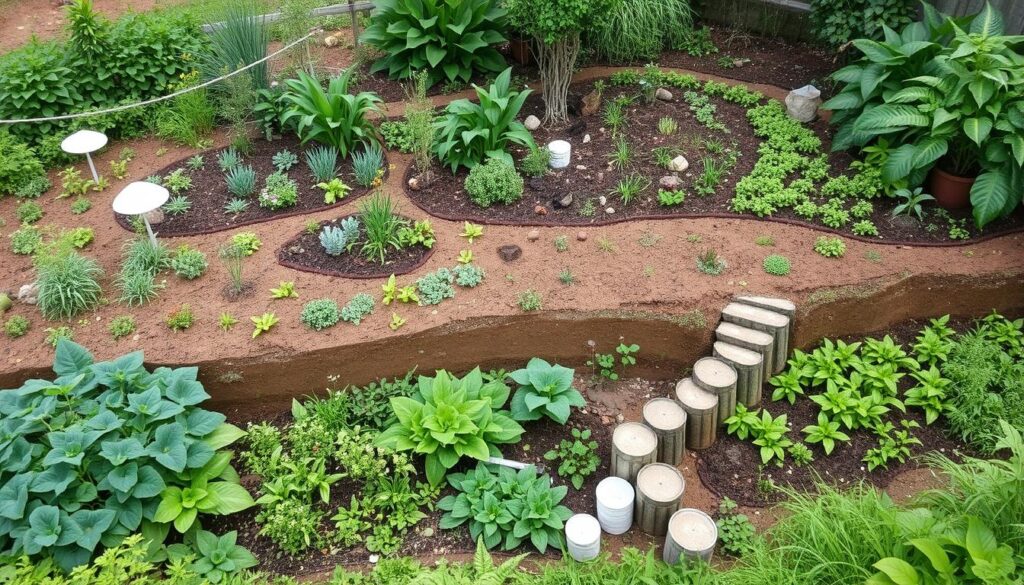
- Composting, which involves the decomposition of organic matter to create a nutrient-rich soil amendment
- Using worm bins and vermi-composting systems to recycle carbon and transform organic waste into valuable soil nutrients
- Applying hot composting techniques to accelerate soil succession and improve soil conditions
By using these methods and ecological design, we can build thriving permaculture systems. These systems support soil health and biodiversity, leading to a more sustainable and circular economy.
| Method | Description |
|---|---|
| Composting | Decomposition of organic matter to create a nutrient-rich soil amendment |
| Worm bins and vermi-composting | Recycling of carbon and transformation of organic waste into valuable soil nutrients |
| Hot composting | Acceleration of soil succession and improvement of soil conditions |
Inputs and Outputs in Permaculture
Permaculture systems need good management of inputs and outputs to stay balanced and productive. They use resources like water and nutrients to create a sustainable environment. By using regenerative agriculture, people can make systems that use resources well and reduce waste, helping the ecosystem.
Organic waste management is key in this process. It turns waste into useful inputs for other processes. For instance, composting food waste makes nutrient-rich soil for crops and cuts down landfill waste. This way, people can make systems that have fewer bad outputs and more good inputs.
- Identifying available resources and their potential uses
- Designing systems that minimize waste and maximize efficiency
- Implementing organic waste management practices, such as composting and recycling
- Monitoring and adjusting the system as needed to maintain balance and productivity
By focusing on inputs and outputs, people can make permaculture systems that are sustainable and regenerative. This approach helps create a healthier environment and more resilient ecosystems. It can be applied in many areas of permaculture, like soil health, biodiversity, water cycling, and energy efficiency, leading to a more sustainable future.
| Input | Output |
|---|---|
| Organic waste | Compost, nutrient-rich soil amendments |
| Rainwater | Irrigation, water storage |
| Sunlight | Energy, photosynthesis |
Closed-Loop Systems in Permaculture
Permaculture material cycles are key for managing resources sustainably. Closed-loop systems in permaculture aim to use resources well, cutting down on waste. This makes the system more efficient and helps it grow back stronger.
For example, using brewery waste to grow mushrooms is a closed-loop system. The mushrooms are sold, and the leftover is fed to pigs. This shows how permaculture can make systems sustainable and efficient.
Some benefits of closed-loop systems in permaculture include:
- Reduced waste and pollution
- Increased efficiency and productivity
- Promotion of sustainable resource management
- Enhanced biodiversity and ecosystem services
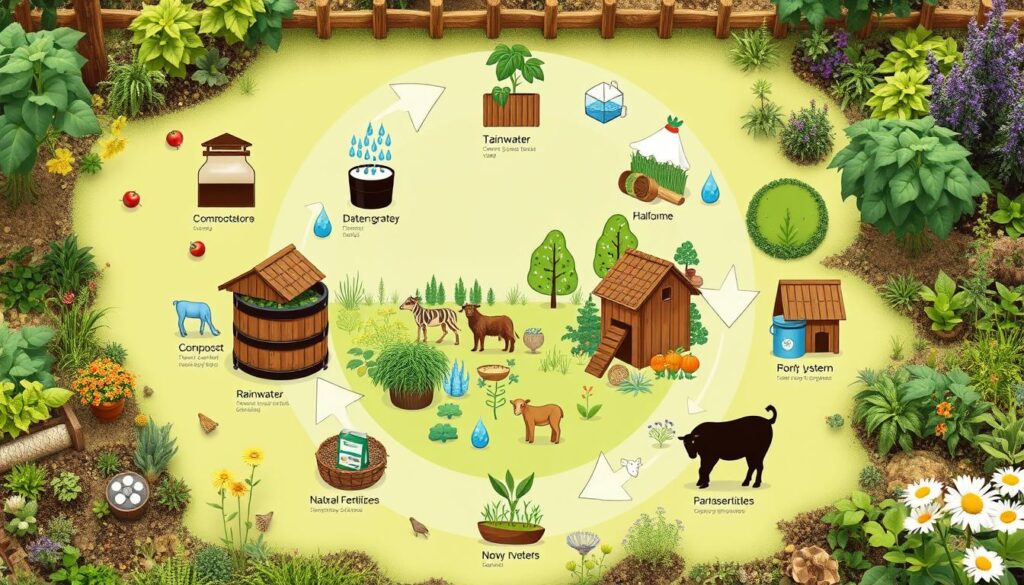
By using closed-loop systems, permaculture can make our food system greener and stronger. This helps our environment and makes our food system more resilient.
| System | Benefits |
|---|---|
| Closed-loop systems | Reduced waste, increased efficiency, promoted sustainability |
| Permaculture material cycles | Enhanced biodiversity, ecosystem services, and sustainable resource management |
The Water Cycle in Permaculture
Using ecological design in permaculture is key for efficient water use. It helps reduce water waste and supports sustainable water use. For example, collecting rainwater for irrigation and toilet use is a great start.
Keeping water clean is also important. Wetlands and swales act as natural filters, removing harmful substances. Organic mulch helps lower water loss, reducing the need for irrigation.
Some benefits of rainwater harvesting include:
- Reduced water costs
- Increased water self-sufficiency
- Decreased stormwater runoff
By using ecological design and circular economy practices, we can make water systems more efficient. This not only saves water but also makes our environment healthier. It also cuts down on the need for municipal water.
| Water Conservation Method | Benefits |
|---|---|
| Rainwater Harvesting | Reduced water costs, increased water self-sufficiency |
| Greywater Recycling | Decreased water consumption, reduced wastewater generation |
Organic Waste Management
Managing organic waste is key for healthy soil and regenerative farming. Composting breaks down organic materials into a soil booster. Green manures, grown for their nutrient value, help too.
Composting works in small gardens and big farms. The right mix of carbon and nitrogen is 30:1. Keeping the pile moist at 40-60% helps it decompose well.
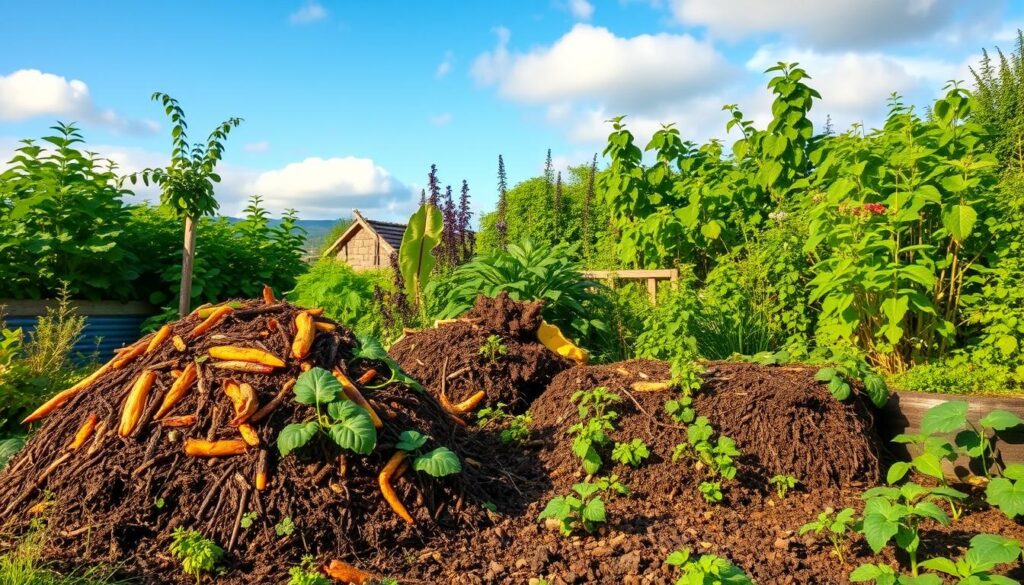
Compost piles can get hot, up to 140°F. This is good for breaking down organic matter. Materials like leaves and kitchen scraps are great for compost. But avoid meat and diseased plants to stop pests and diseases.
| Material | Carbon-to-Nitrogen Ratio |
|---|---|
| Leaves | 60:1 |
| Shredded paper | 170:1 |
| Wood chips | 400:1 |
| Kitchen scraps | 15:1 |
| Animal manures | 10:1 |
Using these methods makes farming better for the planet. It cuts down waste and boosts soil health. This leads to a stronger, more productive farm system.
Biodiversity and Ecosystem Functioning
Permaculture material cycles are key to boosting biodiversity and ecosystem health. They help manage resources sustainably. This leads to better ecosystem services like pollination and nutrient cycling. A study showed permaculture sites have 27% more soil carbon and 201% more earthworms than non-permaculture fields.
These results show how vital permaculture is for biodiversity and ecosystem health. Some main benefits include:
- Enhanced ecosystem services, such as pollination and nutrient cycling
- Increased soil carbon stocks and earthworm abundance
- Improved climate regulation and resilience to environmental changes
Experts say permaculture design can fight climate change and manage resources sustainably. It helps create resilient, diverse ecosystems. These ecosystems can better face environmental challenges.
A program in China’s Loess Plateau restored over 35,000 square kilometers of land in 15 years. This shows permaculture’s power in boosting ecosystem functioning and biodiversity. As sustainable resource management grows in importance, permaculture will be crucial for ecosystem health and biodiversity.
By following permaculture, we can build sustainable, resilient ecosystems. These ecosystems help fight climate change and improve ecosystem functioning. For more on permaculture, visit permaculture practice websites. Learn about the benefits of permaculture material cycles and sustainable resource management.
Seasonal Changes and Their Impact
As seasons change, permaculture systems must adjust to stay strong and sustainable. They use ecological design and circular economy to handle these changes. In autumn, gardens change a lot, with colors shifting from green to yellow, red, and brown.
Wildlife like squirrels show up, needing protection like chicken wire cages for plants. Growing bulbs in pots makes them stronger and easier to plant. As leaves fall, it’s easier to see wildlife tracks and spot birds.
Adapting Material Cycles
To handle seasonal changes, permaculture uses sheet mulching and lasagna gardening. These methods help build soil after growing season. Composting adds nutrients to the soil, boosting biodiversity.
Key strategies include:
- Sheet mulching and lasagna gardening for soil building
- Composting for soil nutrients and biodiversity
- Ecological design for seasonal management
- Circular economy for sustainability
These strategies help permaculture systems stay strong and sustainable, even with seasonal changes.
| Season | Strategies for Adapting Material Cycles |
|---|---|
| Autumn | Sheet mulching, lasagna gardening, composting |
| Winter | Protecting plants from frost, implementing circular economy practices |
| Spring | Implementing ecological design principles, using compost to enhance soil health |
| Summer | Managing seasonal fluctuations, applying circular economy practices |
Educational Strategies for Permaculture
Teaching about material cycles and regenerative agriculture is key for permaculture. It helps inspire a new generation of sustainable farmers and environmental stewards. For example, the Institute for Permaculture Education in Portland, Oregon, offers training for educators.
Getting the community involved is also vital for permaculture success. By working together, we can manage organic waste better and lessen our environmental footprint. Schools like Hood River Middle School have been using permaculture for over a decade.
Some effective ways to teach permaculture include:
- Hands-on learning experiences, such as designing and building permaculture systems
- Integrating permaculture concepts into existing curricula, such as science and mathematics
- Encouraging community involvement and participation in permaculture initiatives
By using these methods, we can support regenerative agriculture and organic waste management. This helps create a more sustainable future.
| Permaculture Initiative | Location | Impact |
|---|---|---|
| Food and Conservation Science Program (FACS) | Hood River Middle School | Reduced waste, increased food production |
| Institute for Permaculture Education | Portland, Oregon | Trained educators in permaculture design |
Case Studies of Successful Permaculture Projects
Permaculture material cycles and sustainable resource management have been successfully applied in various projects around the world. One notable example is the Zaytuna Farm in Australia, which covers 66 acres and has been regenerating since 2001. This project shows how permaculture can improve soil health, reduce erosion, and boost biodiversity.
Another example is the Village Homes in California, which occupies 70 acres and includes 23 acres of agricultural land. The project uses swales to direct stormwater to trees and plants. This helps manage water and shows the power of permaculture in water management. The success of these projects proves the value of sustainable resource management in permaculture.
Some key benefits of permaculture projects include:
- Reduced soil erosion and improved soil health
- Increased biodiversity and ecosystem functioning
- Minimized water usage and improved soil water retention
- Reduced reliance on chemical fertilizers and decreased pollution levels
These case studies show the potential of permaculture material cycles and sustainable resource management. They create resilient and thriving ecosystems. By using these principles, communities can improve food security, reduce environmental impact, and promote sustainable living.
| Project | Location | Key Features |
|---|---|---|
| Zaytuna Farm | Australia | 66 acres, regenerating since 2001 |
| Village Homes | California | 70 acres, 23 acres of agricultural land, swales for water management |
Conclusion: The Future of Material Cycles in Permaculture
The future of material cycles in permaculture looks promising. Ecological design, circular economy practices, and regenerative agriculture techniques will play key roles. New sustainable technologies, community efforts, and policies will drive this change.
In the United States, more farmers are turning to permaculture. About 30,000 farmers are leading this shift. This shows a global move towards more sustainable food systems.
Permaculture focuses on natural cycles and balance. It offers a way to achieve economic and ecological stability. By focusing on diversity and closed-loop systems, permaculture helps communities face challenges.
Soil health, water conservation, and biodiversity are key. They help tackle climate change and resource scarcity. As leaders see the value, the future of permaculture looks bright. It’s a step towards a more sustainable world.

